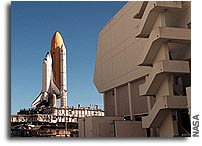NASA to Shut Down Checkout & Launch Control System
 NASA Headquarters has decided to terminate the CLCS (Checkout & Launch Control System) at NASA Kennedy Space Center (KSC). Instead, attention will be focused upon supporting the portion of the existing LPS (Launch Processing System), which the CLCS was originally intended to replace.
NASA Headquarters has decided to terminate the CLCS (Checkout & Launch Control System) at NASA Kennedy Space Center (KSC). Instead, attention will be focused upon supporting the portion of the existing LPS (Launch Processing System), which the CLCS was originally intended to replace.
The CLCS was intended to replace the Checkout, Control and Monitor Subsystem (CCMS) a central component of the existing LPS. The original justification in 1997 for the CLCS noted that a substantial portion of the vendors for the CCMS no longer provided support. Moreover, software was out of date, significant training was required for systems that were no longer state of the art, and the cost for all of this was expected to rise. The CLCS promised to reduce people, paperwork, and operations and maintenance costs by 50%.
The prime reason for this current decision is a determination by NASA Headquarters that the expected implementation of CLCS does not offer the significant cost savings over the anticipated life of the Space Shuttle program – as had been promised.
Moreover, the aim of the CLCS effort has changed from its original focus on dealing with obsolescence to one established by NASA KSC that is focused on growth potential, safety, and operations efficiency. Given rising CLCS costs, and continued schedule slips, NASA HQ felt that there would not be a significant improvement in capability for the money that would have been spent on continuing the CLCS.
A significant number of contractor layoffs (as many as 400) will likely result from this decision.
The following is a NASA KSC description of what the Checkout & Launch Control System (CLCS) was intended to accomplish:
“Rapid advancements in digital data processing and communications, plus increased launch processing requirements for the Space Shuttle, have led NASA to call for a replacement for the CCMS subsystem of the LPS. At the same time, a new test control and monitor system for the International Space Station and future NASA launch systems will be needed. All of these requirements will be met through a follow on of the Checkout & Launch Control System (CLCS ) Project. The new CLCS design utilizes state-of-the-art, real-time computers; modern graphic displays; multi-tasking software and communications devices; and advanced design, development and testing capabilities.
A building block approach that allows the system to be upgraded with the latest commercial off-the-shelf hardware and software serves as the basis of the CLCS design. This methodology allows CLCS to be adaptable to a wide range of system and testing needs, and to economically sustain a 30-year-plus lifetime.
CLCS has interfaces with flight hardware and ground support equipment; a high-speed, high-capacity, real-time network; a large-scale data base subsystem; multiple archival and retrieval subsystems; a software production facility; a high-speed display network subsystem; and a modern display processing subsystem where operators will control and supervise test and checkout operations from high-quality color graphics workstations. Here, they will be able to perform multiple functions at the same time in a multi-tasking environment, while being provided with information on the status of the test proceedings and the condition of the test article.
Each CLCS firing room will have the capability to support over 100 locally connected computers, and can support multiple tests at the same time. During the tests, up to 50,000 changes in measurements will be monitored every second. If any of these measurements indicate a potentially dangerous condition, the system will respond to the emergency in less than 20 milliseconds. Currently, the old Firing Room 4, now called Operational Control Room 1 (OCR-1) is operational with a CLCS computer set.”








